nginx_rtmp_module 之 ngx_rtmp_mp4_module 的mp4源码分析
一:整体代码函数预览
static?ngx_int_t
ngx_rtmp_mp4_postconfiguration(ngx_conf_t?*cf)
{
????ngx_rtmp_play_main_conf_t??????*pmcf;
????ngx_rtmp_play_fmt_t???????????**pfmt,?*fmt;
????pmcf?=?ngx_rtmp_conf_get_module_main_conf(cf,?ngx_rtmp_play_module);
????pfmt?=?ngx_array_push(&pmcf->fmts);
????if?(pfmt?==?NULL)?{
????????return?NGX_ERROR;
????}
????fmt?=?ngx_pcalloc(cf->pool,?sizeof(ngx_rtmp_play_fmt_t));
????if?(fmt?==?NULL)?{
????????return?NGX_ERROR;
????}
????*pfmt?=?fmt;
????ngx_str_set(&fmt->name,?"mp4-format");
????ngx_str_set(&fmt->pfx,?"mp4:");
????ngx_str_set(&fmt->sfx,?".mp4");
????fmt->init??=?ngx_rtmp_mp4_init; // 初始化
????fmt->done??=?ngx_rtmp_mp4_done; // 完成
????fmt->seek??=?ngx_rtmp_mp4_seek; // seek
????fmt->start?=?ngx_rtmp_mp4_start; // 开始
????fmt->stop??=?ngx_rtmp_mp4_stop; // 结束
????fmt->send??=?ngx_rtmp_mp4_send; // 发送数据
????return?NGX_OK;
}二:数据结构定义
| 定义 | 标准定义 | nginx 数据结构定义 |
| stsc 【Sample To Chunk Box】 | 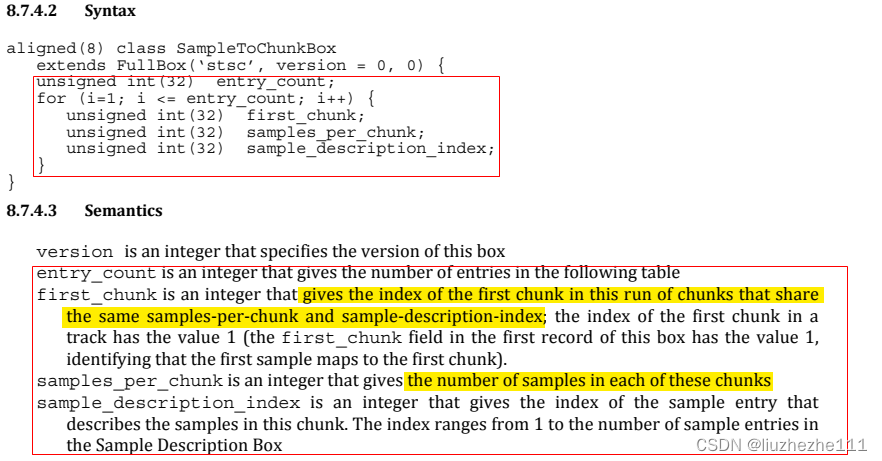 | type 4 字节已经偏移过, box_size 4 字节已经偏移过 typedef?struct?{ ????uint32_t????????????????????????????first_chunk; ????uint32_t????????????????????????????samples_per_chunk; ????uint32_t????????????????????????????sample_descrption_index; }?ngx_rtmp_mp4_chunk_entry_t; typedef?struct?{ ????uint32_t????????????????????????????version_flags; ????uint32_t????????????????????????????entry_count; ????ngx_rtmp_mp4_chunk_entry_t??????????entries[0]; }?ngx_rtmp_mp4_chunks_t; |
| stts 【Decoding Time to Sample Box】 | 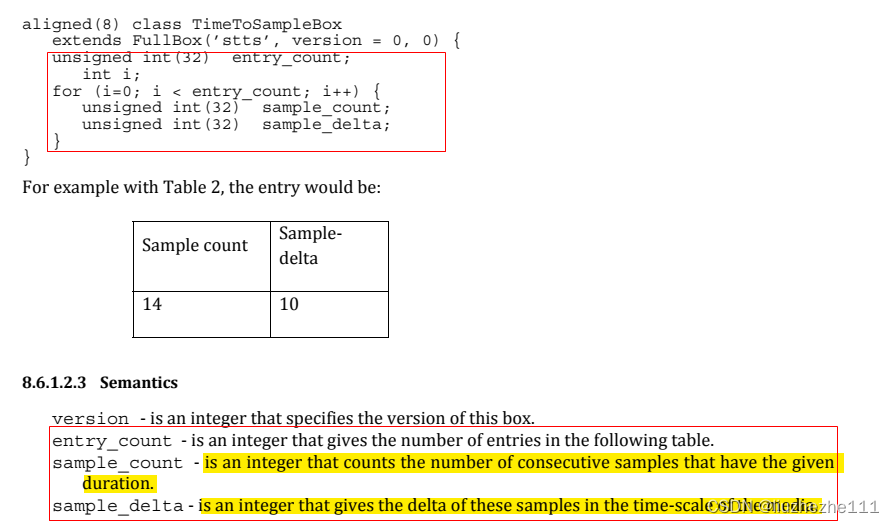 | type 4 字节已经偏移过, box_size 4 字节已经偏移过 typedef?struct?{ ????uint32_t????????????????????????????sample_count; ????uint32_t????????????????????????????sample_delta; }?ngx_rtmp_mp4_time_entry_t; typedef?struct?{ ????uint32_t????????????????????????????version_flags; ????uint32_t????????????????????????????entry_count; ????ngx_rtmp_mp4_time_entry_t???????????entries[0]; }?ngx_rtmp_mp4_times_t; |
| ctts 【Composition Time to Sample Box】 |  | type 4 字节已经偏移过, box_size 4 字节已经偏移过 typedef?struct?{ ????uint32_t????????????????????????????sample_count; ????uint32_t????????????????????????????sample_offset; }?ngx_rtmp_mp4_delay_entry_t; typedef?struct?{ ????uint32_t????????????????????????????version_flags; ????uint32_t????????????????????????????entry_count; ????ngx_rtmp_mp4_delay_entry_t??????????entries[0]; }?ngx_rtmp_mp4_delays_t; |
| stss 【Sync Sample Box】 | 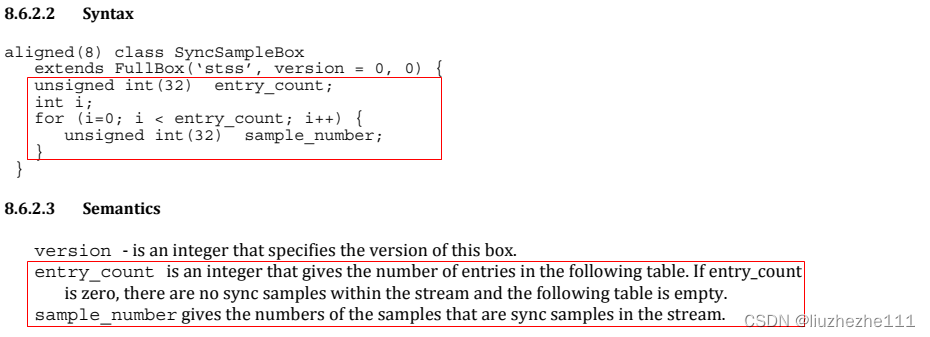 | type 4 字节已经偏移过, box_size 4 字节已经偏移过 typedef?struct?{ ????uint32_t????????????????????????????version_flags; ????uint32_t????????????????????????????entry_count; ????uint32_t????????????????????????????entries[0]; }?ngx_rtmp_mp4_keys_t; |
| stsz 【Sample Size Boxes】 |  | type 4 字节已经偏移过, box_size 4 字节已经偏移过 typedef?struct?{ ????uint32_t????????????????????????????version_flags; 4 字节 ????uint32_t????????????????????????????sample_size; ????uint32_t????????????????????????????sample_count; ????uint32_t????????????????????????????entries[0]; }?ngx_rtmp_mp4_sizes_t; |
| stco 【Chunk Offset Box】 co64 | 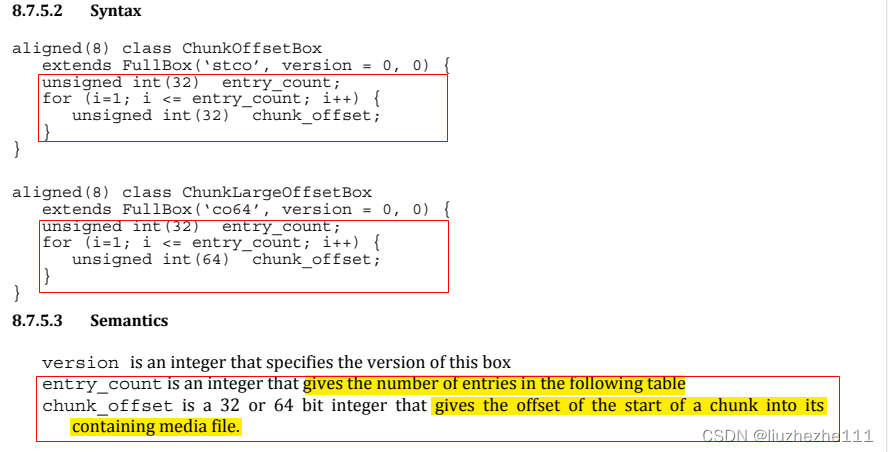 | type 4 字节已经偏移过, box_size 4 字节已经偏移过 typedef?struct?{ ????uint32_t????????????????????????????version_flags; 4 字节固定 ????uint32_t????????????????????????????entry_count; ????uint32_t????????????????????????????entries[0]; }?ngx_rtmp_mp4_offsets_t; typedef?struct?{ ????uint32_t????????????????????????????version_flags; ????uint32_t????????????????????????????entry_count; ????uint64_t????????????????????????????entries[0]; }?ngx_rtmp_mp4_offsets64_t; |
三:数据结构解析
static?ngx_rtmp_mp4_box_t???????????????????????ngx_rtmp_mp4_boxes[]?=?{
????{?ngx_rtmp_mp4_make_tag('t','r','a','k'),???ngx_rtmp_mp4_parse_trak???},
????{?ngx_rtmp_mp4_make_tag('m','d','i','a'),???ngx_rtmp_mp4_parse????????},
????{?ngx_rtmp_mp4_make_tag('m','d','h','d'),???ngx_rtmp_mp4_parse_mdhd???},
????{?ngx_rtmp_mp4_make_tag('h','d','l','r'),???ngx_rtmp_mp4_parse_hdlr???},
????{?ngx_rtmp_mp4_make_tag('m','i','n','f'),???ngx_rtmp_mp4_parse????????},
????{?ngx_rtmp_mp4_make_tag('s','t','b','l'),???ngx_rtmp_mp4_parse????????},
????{?ngx_rtmp_mp4_make_tag('s','t','s','d'),???ngx_rtmp_mp4_parse_stsd???},
????{?ngx_rtmp_mp4_make_tag('s','t','s','c'),???ngx_rtmp_mp4_parse_stsc???}, // 记录了每个chunk中包含多少sample
????{?ngx_rtmp_mp4_make_tag('s','t','t','s'),???ngx_rtmp_mp4_parse_stts???}, // sample 解码时间的压缩表
????{?ngx_rtmp_mp4_make_tag('c','t','t','s'),???ngx_rtmp_mp4_parse_ctts???}, // 帧解码到渲染的时间差值,通常用在B帧的场景,sample的CTS与DTS的时间差的压缩表
????{?ngx_rtmp_mp4_make_tag('s','t','s','s'),???ngx_rtmp_mp4_parse_stss???}, // 关键帧映射表
????{?ngx_rtmp_mp4_make_tag('s','t','s','z'),???ngx_rtmp_mp4_parse_stsz???}, // 每帧数据的大小
????{?ngx_rtmp_mp4_make_tag('s','t','z','2'),???ngx_rtmp_mp4_parse_stz2???},
????{?ngx_rtmp_mp4_make_tag('s','t','c','o'),???ngx_rtmp_mp4_parse_stco???}, // 记录了chunk对应的offset
????{?ngx_rtmp_mp4_make_tag('c','o','6','4'),???ngx_rtmp_mp4_parse_co64???},
????{?ngx_rtmp_mp4_make_tag('a','v','c','1'),???ngx_rtmp_mp4_parse_avc1???},
????{?ngx_rtmp_mp4_make_tag('a','v','c','C'),???ngx_rtmp_mp4_parse_avcC???}, // sps pps 解析
????{?ngx_rtmp_mp4_make_tag('m','p','4','a'),???ngx_rtmp_mp4_parse_mp4a???},
????{?ngx_rtmp_mp4_make_tag('m','p','4','v'),???ngx_rtmp_mp4_parse_mp4v???},
????{?ngx_rtmp_mp4_make_tag('e','s','d','s'),???ngx_rtmp_mp4_parse_esds???},
????{?ngx_rtmp_mp4_make_tag('.','m','p','3'),???ngx_rtmp_mp4_parse_mp3????},
????{?ngx_rtmp_mp4_make_tag('n','m','o','s'),???ngx_rtmp_mp4_parse_nmos???},
????{?ngx_rtmp_mp4_make_tag('s','p','e','x'),???ngx_rtmp_mp4_parse_spex???},
????{?ngx_rtmp_mp4_make_tag('w','a','v','e'),???ngx_rtmp_mp4_parse????????}
};ngx_rtmp_mp4_parse_stsc?? 记录了每个chunk中包含多少sample

上图数据解析
00 00 00 28(size) --> 40 字节总大小包含的自己在内的所有数据:
00 00 00 28(size) 73 74 73 63(stsc) 00 00 00 00(version_flags) 00 00 00 02(entry_count) 00 00 00 01(first_chunk) 00 00 00 02(samples_per_chunk) 00 00 00 01(sample_descrption_index) 00 00 00 02(first_chunk) 00 00 00 01(samples_per_chunk) 00 00 00 01(sample_descrption_index)
static?ngx_int_t
ngx_rtmp_mp4_parse_stsc(ngx_rtmp_session_t?*s,?u_char?*pos,?u_char?*last)
{
????ngx_rtmp_mp4_ctx_t?????????*ctx;
????ngx_rtmp_mp4_track_t???????*t;
????ctx?=?ngx_rtmp_get_module_ctx(s,?ngx_rtmp_mp4_module);
????t?=?ctx->track;
????if?(t?==?NULL)?{
????????return?NGX_OK;
????}
????t->chunks?=?(ngx_rtmp_mp4_chunks_t?*)?pos; // 内存数据上面的解析
????if?(pos?+?sizeof(*t->chunks)?+?ngx_rtmp_r32(t->chunks->entry_count)?*
???????????????????????????????????sizeof(t->chunks->entries[0])
????????<=?last)// 内存越界判断
????{
????????return?NGX_OK;
????}
????t->chunks?=?NULL;
????return?NGX_ERROR;
}ngx_rtmp_mp4_parse_stco? 记录了chunk对应的offset
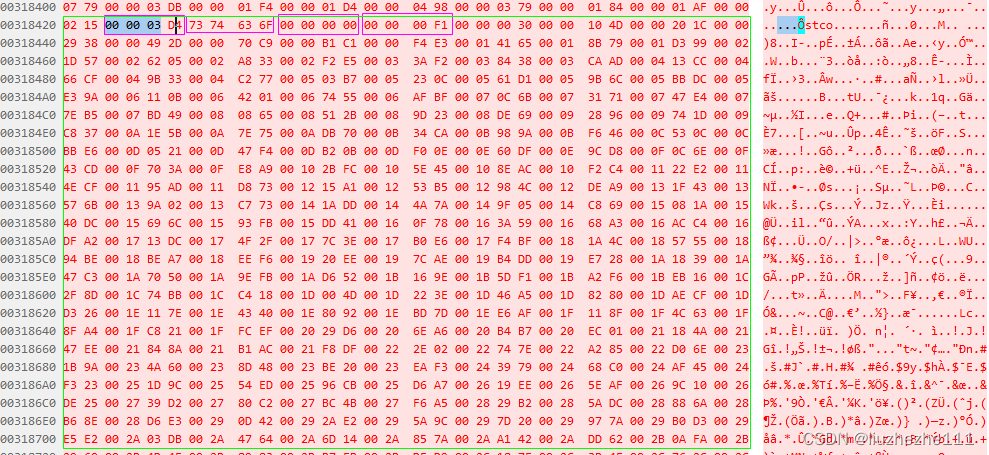
00 00 03 D4(980 长度) 73 74 63 6F (stco)00 00 00 00(version_flags) 00 00 00 F1( entry_count 241 ) 00 00 00 30(?entrie) 00 00 10 4D (?entrie)00 00 20 1C(?entrie) 00 00 29 38(?entrie) 00 00 49 2D(?entrie) 00 00 70 C9(?entrie) 00 00 B1 C1 (?entrie) ...............
static?ngx_int_t
ngx_rtmp_mp4_parse_stco(ngx_rtmp_session_t?*s,?u_char?*pos,?u_char?*last)
{
????ngx_rtmp_mp4_ctx_t?????????*ctx;
????ngx_rtmp_mp4_track_t???????*t;
????ctx?=?ngx_rtmp_get_module_ctx(s,?ngx_rtmp_mp4_module);
????t?=?ctx->track;
????if?(t?==?NULL)?{
????????return?NGX_OK;
????}
????t->offsets?=?(ngx_rtmp_mp4_offsets_t?*)?pos; // 数据结构的赋值
????if?(pos?+?sizeof(*t->offsets)?+?ngx_rtmp_r32(t->offsets->entry_count)?*
????????????????????????????????????sizeof(t->offsets->entries[0])
????????<=?last) // 内存越界判断
????{
????????return?NGX_OK;
????}
????t->offsets?=?NULL;
????return?NGX_ERROR;
}其他数据结构的解析与上面的流程基本一样
四:数据处理流程
五:play 流程代码分析
ffplay -analyzeduration 1000000 "rtmp://10.90.103.5/vod/0001.mp4
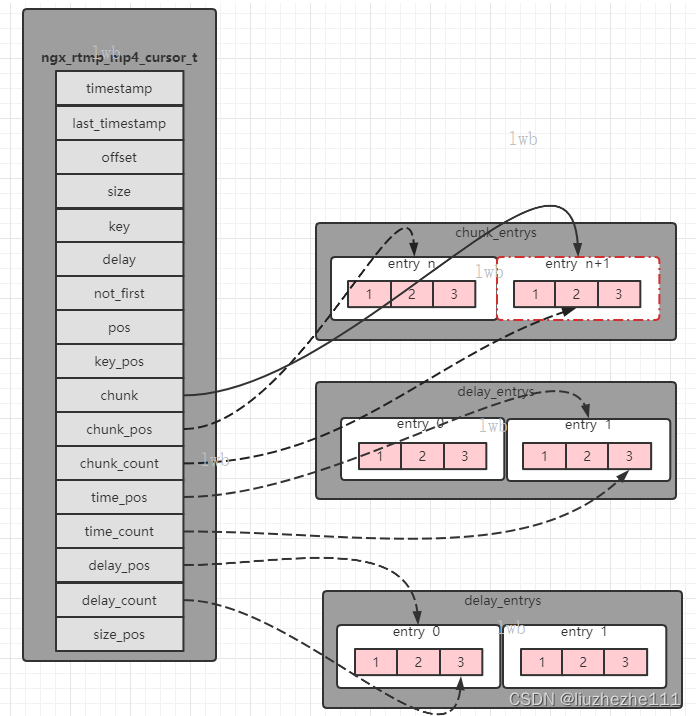

1> ngx_rtmp_mp4_init 初始化变量解析 mp4 moov box 的数据结构
2> ngx_rtmp_mp4_seek (ngx_rtmp_session_t?*s,?ngx_file_t?*f,?ngx_uint_t?timestamp), timestamp = 0 ,seek 时间戳为零标识从头开始播放。ngx_rtmp_mp4_seek_track 有两个轨道,音频轨和视频轨,分别进行seek
static?ngx_int_t
ngx_rtmp_mp4_seek_track(ngx_rtmp_session_t?*s,?ngx_rtmp_mp4_track_t?*t,
????????????????????????ngx_int_t?timestamp)
{
????ngx_rtmp_mp4_cursor_t??????????*cr;
????cr?=?&t->cursor;
????ngx_memzero(cr,?sizeof(*cr));
????if?(ngx_rtmp_mp4_seek_time(s,?t,?ngx_rtmp_mp4_from_rtmp_timestamp( // ngx_rtmp_mp4_from_rtmp_timestamp 时间戳的
??????????????????????????t,?timestamp))?!=?NGX_OK?||
????????ngx_rtmp_mp4_seek_key(s,?t)???!=?NGX_OK?||
????????ngx_rtmp_mp4_seek_chunk(s,?t)?!=?NGX_OK?||
????????ngx_rtmp_mp4_seek_size(s,?t)??!=?NGX_OK?||
????????ngx_rtmp_mp4_seek_delay(s,?t)?!=?NGX_OK)
????{
????????return?NGX_ERROR;
????}
????cr->valid?=?1;
????return?NGX_OK;
}
// 时间戳的转换函数,mp4 文件到rtmp
// rtmp_mp4 存放的是timescale 时间戳 通常是 12288
// rtmp 时间刻度通常是 1000
static?ngx_inline?uint32_t
ngx_rtmp_mp4_to_rtmp_timestamp(ngx_rtmp_mp4_track_t?*t,?uint64_t?ts) // 给定一个时间值 从rtmp_mp4 12288 刻度转换到 1000
{
????return?(uint32_t)?(ts?*?1000?/?t->time_scale);
}
static?ngx_inline?uint32_t
ngx_rtmp_mp4_from_rtmp_timestamp(ngx_rtmp_mp4_track_t?*t,?uint32_t?ts) // 给定一个时间值 从rtmp 1000 刻度转换到12288
{
????return?(uint64_t)?ts?*?t->time_scale?/?1000;
}ngx_rtmp_mp4_seek_time :
| stts: typedef?struct?{ ????uint32_t????????????????????????????sample_count; ????uint32_t????????????????????????????sample_delta; }?ngx_rtmp_mp4_time_entry_t; typedef?struct?{ ????uint32_t????????????????????????????version_flags; ????uint32_t????????????????????????????entry_count; ????ngx_rtmp_mp4_time_entry_t???????????entries[0]; }?ngx_rtmp_mp4_times_t; | 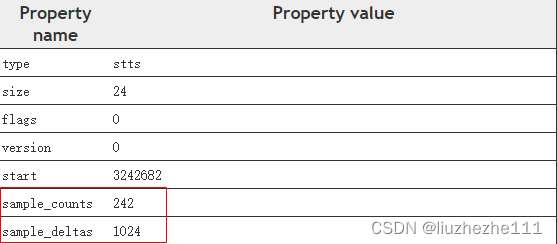 | 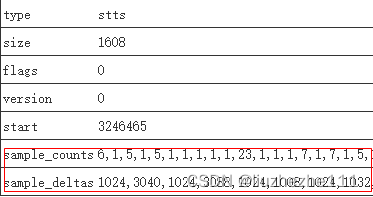 |
static?ngx_int_t
ngx_rtmp_mp4_seek_time(ngx_rtmp_session_t?*s,?ngx_rtmp_mp4_track_t?*t,
???????????????????????uint32_t?timestamp)
{
????ngx_rtmp_mp4_cursor_t??????*cr;
????ngx_rtmp_mp4_time_entry_t??*te;
????uint32_t????????????????????dt;
????if?(t->times?==?NULL)?{
????????return?NGX_ERROR;
????}
????cr?=?&t->cursor; // 对应音频或者视频轨道的游标器
????te?=?t->times->entries; // times --> ngx_rtmp_mp4_times_t
// sample_counts 6,1,5,1,5,1,1,1,1,1
// sample_deltas 1024,3040,1024,3088,1024,1008,1024,1032,1024,1048
// 整个循环就是处理,遍历sample_counts个sample_deltas值与 参数 timestamp比大小. 1. 小于记录 cr->timestamp?+=?dt,
????while?(cr->time_pos?<?ngx_rtmp_r32(t->times->entry_count))?{
????????dt?=?ngx_rtmp_r32(te->sample_delta)?*?ngx_rtmp_r32(te->sample_count); // 242 * 1024 = 22757376
// cr->timestamp?+?dt?>=?timestamp ,在这个范围说明找到
????????if?(cr->timestamp?+?dt?>=?timestamp)?{
????????????if?(te->sample_delta?==?0)?{
????????????????return?NGX_ERROR;
????????????}
????????????cr->time_count?=?(timestamp?-?cr->timestamp)?/
?????????????????????????????ngx_rtmp_r32(te->sample_delta); // sample_delta 相同,cr->time_count 等于当前时间戳距离这个entry开始时间错的插值,的第几个delta
????????????cr->timestamp?+=?ngx_rtmp_r32(te->sample_delta)?*?cr->time_count; // seek 的时间戳,就是把 cr->timestamp 修改当前的时间戳
????????????cr->pos?+=?cr->time_count; // 记录当前seek 对应时间戳具体的位置
????????????break;
????????}
// 没找到,
????????cr->timestamp?+=?dt; // 记录值进行累加,访问下一个
????????cr->pos?+=?ngx_rtmp_r32(te->sample_count); // 记录pos 的位置
????????cr->time_pos++; // 记录已经访问第几个entry
????????te++; // te++ 下一个entry
????}
????if?(cr->time_pos?>=?ngx_rtmp_r32(t->times->entry_count))?{
????????return??NGX_ERROR;
????}
????return?NGX_OK;
}ngx_rtmp_mp4_seek_key
| stss typedef?struct?{ ????uint32_t????????????????????????????version_flags; ????uint32_t????????????????????????????entry_count; // 个数 ????uint32_t????????????????????????????entries[0]; // pos }?ngx_rtmp_mp4_keys_t; | 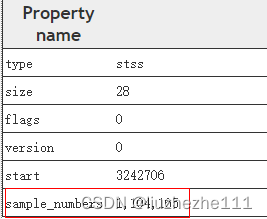 |
static?ngx_int_t
ngx_rtmp_mp4_seek_key(ngx_rtmp_session_t?*s,?ngx_rtmp_mp4_track_t?*t)
{
????ngx_rtmp_mp4_cursor_t??????*cr;
????uint32_t???????????????????*ke;
????ngx_int_t???????????????????dpos;
????cr?=?&t->cursor; // 对应音频或者视频轨道的游标器
????if?(t->keys?==?NULL)?{
????????return?NGX_OK;
????}
// cr->key_pos 初始值为0 ,t->keys->entry_count 关键帧的个数
????while?(cr->key_pos?<?ngx_rtmp_r32(t->keys->entry_count))?{
// 遍历每一个entry得到帧号,与当前pos位置进行对比,找到当前位置的下一个关键帧
????????if?(ngx_rtmp_r32(t->keys->entries[cr->key_pos])?>?cr->pos)?{ // cr->pos 上面seek 后具体位置
????????????break;
????????}
????????cr->key_pos++;
????}
????if?(cr->key_pos?>=?ngx_rtmp_r32(t->keys->entry_count))?{
????????return?NGX_OK;
????}
????ke?=?&t->keys->entries[cr->key_pos]; //
????dpos?=?ngx_rtmp_r32(*ke)?-?cr->pos?-?1; // 计算距离下一个关键帧的差值
????cr->key?=?1;
????/*?TODO:?range?version?needed?*/
????for?(;?dpos?>?0;?--dpos)?{
????????ngx_rtmp_mp4_next_time(s,?t);
????}
????return?NGX_OK;
}ngx_rtmp_mp4_seek_chunk
| stsc typedef?struct?{ ????uint32_t????????????????????????????first_chunk; ????uint32_t????????????????????????????samples_per_chunk; ????uint32_t????????????????????????????sample_descrption_index; }?ngx_rtmp_mp4_chunk_entry_t; typedef?struct?{ ????uint32_t????????????????????????????version_flags; ????uint32_t????????????????????????????entry_count; ????ngx_rtmp_mp4_chunk_entry_t??????????entries[0]; }?ngx_rtmp_mp4_chunks_t; |  | 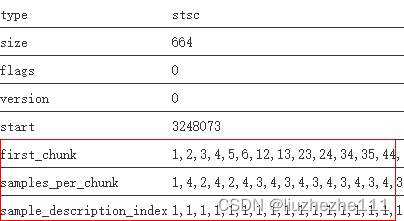 |
static?ngx_int_t
ngx_rtmp_mp4_seek_chunk(ngx_rtmp_session_t?*s,?ngx_rtmp_mp4_track_t?*t)
{
????ngx_rtmp_mp4_cursor_t??????????*cr;
????ngx_rtmp_mp4_chunk_entry_t?????*ce,?*nce;
????ngx_uint_t??????????????????????pos,?dpos,?dchunk;
????cr?=?&t->cursor; // 对应音频或者视频轨道的游标器
????if?(t->chunks?==?NULL?||?t->chunks->entry_count?==?0)?{
????????cr->chunk?=?1;
????????return?NGX_OK;
????}
????ce?=?t->chunks->entries; // entry 实体结构
????pos?=?0;
// cr->chunk_pos 初始值是0
????while?(cr->chunk_pos?+?1?<?ngx_rtmp_r32(t->chunks->entry_count))?{
????????nce?=?ce?+?1; // 下一个entry
????????dpos?=?(ngx_rtmp_r32(nce->first_chunk)?-
????????????????ngx_rtmp_r32(ce->first_chunk))?*
????????????????ngx_rtmp_r32(ce->samples_per_chunk); // 距离下一个chunk总共有多少点,(2-1) * 2 = 2 帧
????????if?(pos?+?dpos?>?cr->pos)?{ // 判断当前位置是不是在这个chunk 中
????????????break;
????????}
????????pos?+=?dpos; // pos 从头遍历累加
????????ce++; // 访问下一个entry
????????cr->chunk_pos++; // chunk_pos ++,记录游标当前在第几个chunk位置
????}
????if?(ce->samples_per_chunk?==?0)?{
????????return?NGX_ERROR;
????}
????dchunk?=?(cr->pos?-?pos)?/?ngx_rtmp_r32(ce->samples_per_chunk); // seek 之后的当前pos 位置,与找到chunk的pos差值,相同连续的chunk 可能不记录写进去。
// 比如: first_chunk 1,2,3,4,5,6,12,13
// samples_per_chunk 1,4,2,4,2,4,3, 4 ---> 1 + 4 + 2 + 4 + 2 + 4 = 17 , 18 --> 38 之间都是; 这个时候会有一个 dchunk差值
????cr->chunk?=?ngx_rtmp_r32(ce->first_chunk)?+?dchunk; // 得到当前游标chunk的值,真实对应chunk 位置。
????cr->chunk_pos?=?(ngx_uint_t)?(ce?-?t->chunks->entries); // cr->chunk_pos 记录的是存储的真实解析位置
????cr->chunk_count?=?(ngx_uint_t)?(cr->pos?-?pos?-?dchunk?*
????????????????????????????????????ngx_rtmp_r32(ce->samples_per_chunk)); // 剩余是 chunk 偏移的变量帧
????return?ngx_rtmp_mp4_update_offset(s,?t);
}
static?ngx_int_t
ngx_rtmp_mp4_update_offset(ngx_rtmp_session_t?*s,?ngx_rtmp_mp4_track_t?*t)
{
????ngx_rtmp_mp4_cursor_t??????????*cr;
????ngx_uint_t??????????????????????chunk;
????cr?=?&t->cursor;
????if?(cr->chunk?<?1)?{
????????return?NGX_ERROR;
????}
????chunk?=?cr->chunk?-?1; // 数组访问 -1
????if?(t->offsets)?{
????????if?(chunk?>=?ngx_rtmp_r32(t->offsets->entry_count))?{
????????????return?NGX_ERROR;
????????}
????????cr->offset?=?(off_t)?ngx_rtmp_r32(t->offsets->entries[chunk]); // 取出第几个chunk偏移大小进行赋值
????????cr->size?=?0;
????????return?NGX_OK;
????}
????if?(t->offsets64)?{
????????if?(chunk?>=?ngx_rtmp_r32(t->offsets64->entry_count))?{
????????????return?NGX_ERROR;
????????}
????????cr->offset?=?(off_t)?ngx_rtmp_r64(t->offsets64->entries[chunk]);
????????cr->size?=?0;
????????return?NGX_OK;
????}
????return?NGX_ERROR;
}ngx_rtmp_mp4_seek_size
| stsz typedef?struct?{ ????uint32_t????????????????????????????version_flags; 4 字节 ????uint32_t????????????????????????????sample_size; ????uint32_t????????????????????????????sample_count; ????uint32_t????????????????????????????entries[0]; }?ngx_rtmp_mp4_sizes_t; |  |
static?ngx_int_t
ngx_rtmp_mp4_seek_size(ngx_rtmp_session_t?*s,?ngx_rtmp_mp4_track_t?*t)
{
????ngx_rtmp_mp4_cursor_t??????*cr;
????ngx_uint_t??????????????????pos;
????cr?=?&t->cursor; // 当前游标
????if?(cr->chunk_count?>?cr->pos)?{ // 》 ??
????????return?NGX_ERROR;
????}
????if?(t->sizes)?{
????????if?(t->sizes->sample_size)?{
????????????cr->size?=?ngx_rtmp_r32(t->sizes->sample_size);
????????????cr->offset?+=?cr->size?*?cr->chunk_count;
????????????return?NGX_OK;
????????}
????????if?(cr->pos?>=?ngx_rtmp_r32(t->sizes->sample_count))?{
????????????return?NGX_ERROR;
????????}
????????for?(pos?=?1;?pos?<=?cr->chunk_count;?++pos)?{ // chunk_count ??
????????????cr->offset?+=?ngx_rtmp_r32(t->sizes->entries[cr->pos?-?pos]);
????????}
????????cr->size_pos?=?cr->pos; // seek 时间戳当前pos
????????cr->size?=?ngx_rtmp_r32(t->sizes->entries[cr->size_pos]); // 获取当前pos对应帧数据大小
????????return?NGX_OK;
????}
????if?(t->sizes2)?{
????????if?(cr->size_pos?>=?ngx_rtmp_r32(t->sizes2->sample_count))?{
????????????return?NGX_ERROR;
????????}
????????cr->size_pos?=?cr->pos;
????????return?NGX_OK;
????}
????return?NGX_ERROR;
}ngx_rtmp_mp4_seek_delay
| ctts typedef?struct?{ ????uint32_t????????????????????????????sample_count; ????uint32_t????????????????????????????sample_offset; }?ngx_rtmp_mp4_delay_entry_t; typedef?struct?{ ????uint32_t????????????????????????????version_flags; ????uint32_t????????????????????????????entry_count; ????ngx_rtmp_mp4_delay_entry_t??????????entries[0]; }?ngx_rtmp_mp4_delays_t; |  |
static?ngx_int_t
ngx_rtmp_mp4_seek_delay(ngx_rtmp_session_t?*s,?ngx_rtmp_mp4_track_t?*t)
{
????ngx_rtmp_mp4_cursor_t??????*cr;
????ngx_rtmp_mp4_delay_entry_t?*de;
????uint32_t????????????????????pos,?dpos;
????cr?=?&t->cursor;
????if?(t->delays?==?NULL)?{
????????return?NGX_OK;
????}
????pos?=?0;
????de?=?t->delays->entries;
????while?(cr->delay_pos?<?ngx_rtmp_r32(t->delays->entry_count))?{ // 遍历所有entry
????????dpos?=?ngx_rtmp_r32(de->sample_count); // 2 表示:sample的个数
????????if?(pos?+?dpos?>?cr->pos)?{ // 0 + 2 > 0 , 当前pos 帧在其中
????????????cr->delay_count?=?cr->pos?-?pos; // 差值 count
????????????cr->delay?=?ngx_rtmp_r32(de->sample_offset); // 偏移大小
????????????break;
????????}
????????cr->delay_pos++; // 记录entry访问的位置
????????pos?+=?dpos; // pos 累加计数
????????de++; // 下一个entry
????}
????if?(cr->delay_pos?>=?ngx_rtmp_r32(t->delays->entry_count))?{
????????return?NGX_OK;
????}
????return?NGX_OK;
}3> ngx_rtmp_mp4_next play 播放一直取下一帧数据
static?ngx_int_t
ngx_rtmp_mp4_next(ngx_rtmp_session_t?*s,?ngx_rtmp_mp4_track_t?*t)
{
????if?(ngx_rtmp_mp4_next_time(s,?t)??!=?NGX_OK?||
????????ngx_rtmp_mp4_next_key(s,?t)???!=?NGX_OK?||
????????ngx_rtmp_mp4_next_chunk(s,?t)?!=?NGX_OK?||
????????ngx_rtmp_mp4_next_size(s,?t)??!=?NGX_OK?||
????????ngx_rtmp_mp4_next_delay(s,?t)?!=?NGX_OK)
????{
????????t->cursor.valid?=?0;
????????return?NGX_ERROR;
????}
????t->cursor.valid?=?1;
????return?NGX_OK;
}六:代码调试
使用进行查看变量的值: ngx_rtmp_r32(t->delays->entry_count)
本文来自互联网用户投稿,该文观点仅代表作者本人,不代表本站立场。本站仅提供信息存储空间服务,不拥有所有权,不承担相关法律责任。 如若内容造成侵权/违法违规/事实不符,请联系我的编程经验分享网邮箱:chenni525@qq.com进行投诉反馈,一经查实,立即删除!
- Python教程
- 深入理解 MySQL 中的 HAVING 关键字和聚合函数
- Qt之QChar编码(1)
- MyBatis入门基础篇
- 用Python脚本实现FFmpeg批量转换
- 【IO】IO模型与零拷贝
- 推荐系统/电商中的 业务指标GMV
- docker版zerotier-planet服务端搭建
- libp2p服务发现之 Multicast DNS(mDNS)
- 案例116:基于微信小程序的大学生就业平台设计与实现
- 2.IHRM人力资源 - 登录
- 洗地机哪款最好用?2024家用洗地机排行榜前十名品牌
- 2024最新:optee系统开发精讲 - 课程介绍
- 系统蓝屏检查工具bluescreenview和WinDbg对比
- Vue3.2多页签导航来了:让你的应用更加灵活与强大!
